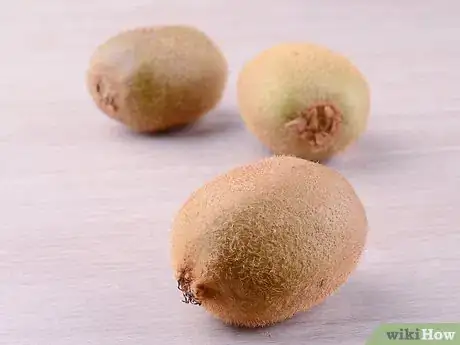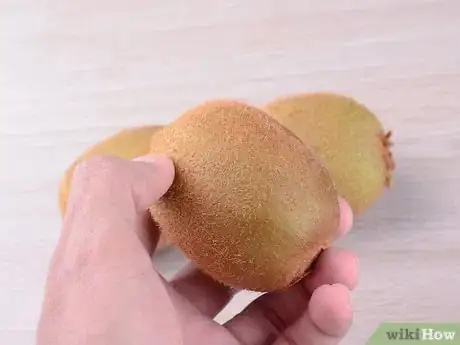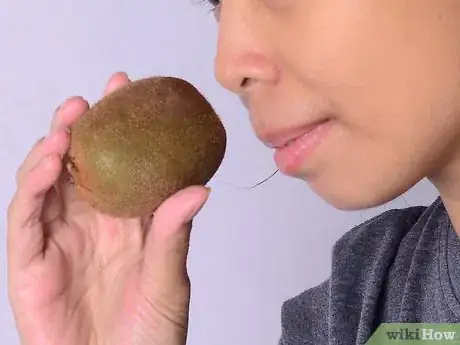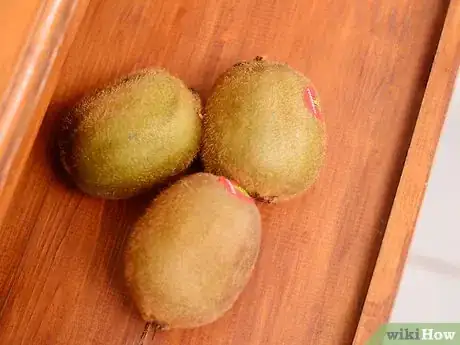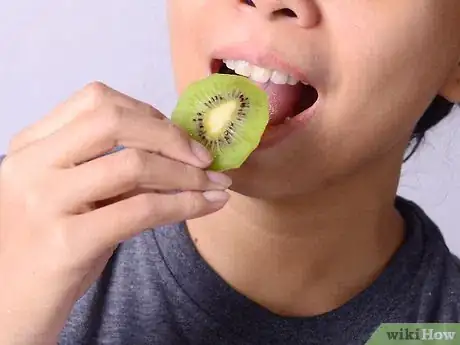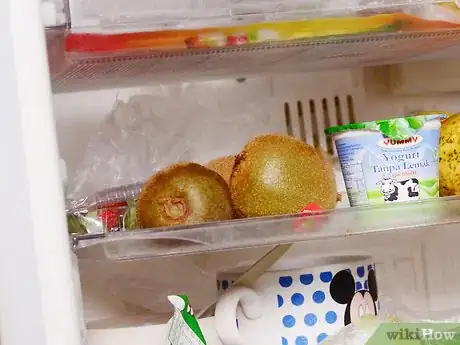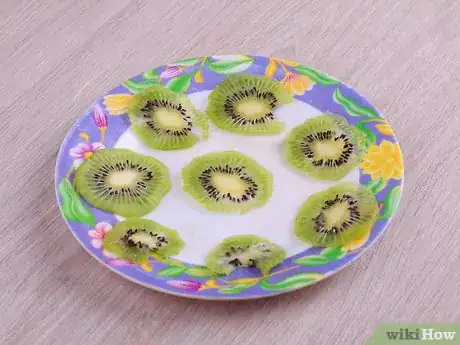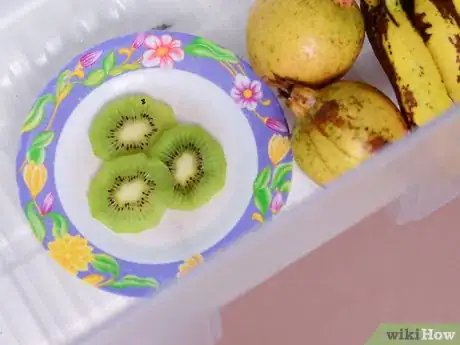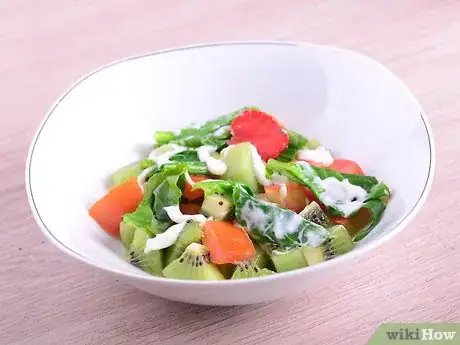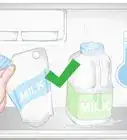This article was co-authored by wikiHow Staff. Our trained team of editors and researchers validate articles for accuracy and comprehensiveness. wikiHow's Content Management Team carefully monitors the work from our editorial staff to ensure that each article is backed by trusted research and meets our high quality standards.
There are 15 references cited in this article, which can be found at the bottom of the page.
wikiHow marks an article as reader-approved once it receives enough positive feedback. In this case, 98% of readers who voted found the article helpful, earning it our reader-approved status.
This article has been viewed 80,950 times.
Learn more...
Kiwi is a delicious fruit that’s native to China and that’s grown extensively in New Zealand. These small green fruits with fuzzy brown skins are loaded with vitamins C and E, fiber, and potassium. When it’s ripe, a kiwi is soft, juicy, sweet, and delicious, but eating an unripe one can be a somewhat unpleasant experience, on account of the hard center and sour fruit. Knowing how to pick kiwis and how to store them at different life stages is key to getting the most enjoyment out of this tasty little fruit.
Steps
Picking Ripe Kiwis
-
1Choose kiwi based on the skin color. Although the fruit inside a kiwi is green (or yellow), you should avoid kiwis that have a greenish hue to their skin.[1] Instead, pick kiwis that have goldish or dark brown skin.
- Kiwis with gold skin will be slightly firmer, and ones with dark brown skin will be softer.[2]
-
2Look for fruit that’s plump. Kiwis are supposed to be juicy and sweet, so look for fruit that looks full, round, and full of juice.[3] Avoid kiwi that looks shrivelled or withered.Advertisement
-
3Inspect kiwis for bruising, blemishes, and wrinkles. The skin of the kiwi should be uniform in color, and not have any dark spots, cuts, or bruises that indicate damage to the fruit.[4] Also look over the fruit for wrinkles, which indicate moisture loss.[5]
- Kiwi with bruises, cuts, or blemishes is still safe to eat. Simply cut out the blemish before eating the rest of the fruit.
-
4Press the fruit gently to test ripeness. Delicately press your thumb into the outside of the fruit. When the kiwi is ripe and ready to eat, the fruit will yield to your squeeze. The fruit should be firm but not mushy or overly soft.[6] If the kiwi doesn’t give when you press it, then it’s not ripe.[7]
- Unripe kiwi will be tart and hard if you try to eat it, but it will ripen if you leave it at room temperature for a few days.[8]
- Overly soft or mushy kiwi is likely bruised, damaged, or overripe, so avoid these kiwis.
- Do not purchase or eat kiwi that’s oozing juice or moldy. Mold on a kiwi may appear as a black, fuzzy green, or brown spot.[9]
-
5Smell the kiwi. Unripe kiwi has no scent, so you can tell when a kiwi is ripe by the aroma. Bring the kiwi to your nose and inhale deeply. A mild fragrant scent indicates that the kiwi is ripe and ready to eat.[10]
Storing Ripe and Unripe Kiwis
-
1Store kiwis on the counter to ripen them. Kiwi is one of those fruits that will continue to ripen after it’s harvested. When you buy unripe kiwi, leave them on the counter at room temperature, and they will ripen over the next three to seven days.
- Other fruits that continue ripening after harvest include apples, bananas, plums, and apricots. There are even a few fruits, like avocados, that won’t ripen unless you pick them.[11]
-
2Transfer unripe kiwis to a paper bag to ripen them faster. Kiwi is a fruit that produces a gas called ethylene, which helps to ripen fruit at an accelerated pace. When you store kiwi in a paper bag, the bag traps the ethylene and ripens the fruit faster.[12]
- Kiwi ripened in a bag will generally ripen twice as quickly as kiwi that’s left to ripen on the counter.
- You can also ripen other fruit faster by storing it in a paper bag with kiwi, or another ethylene-producing fruit.
- Other ethylene-producing fruits include apples, bananas, cantaloupe, grapes, honeydew, mangoes, peaches, pears, potatoes, and tomatoes.
-
3Eat ripe kiwis immediately. Kiwi is ripe when the fruit gives to gentle pressure when you press the fruit with your thumb. Ripe kiwi will also smell fragrant, and have a darker brown skin. Eat the sweet and juicy fruit right away, or store it properly for an extended shelf life.[13]
-
4Transfer kiwis to the refrigerator for longer storage. Once the kiwis have finished ripening, place any leftovers into the refrigerator to preserve them. Ripe kiwi will only last on the counter for a couple of days, but will keep in the refrigerator for one to two weeks.
- You can also store unripe kiwi in the refrigerator for an extended period of time. Place the kiwis in a plastic bag and transfer them to the refrigerator for up to six weeks. When you want to eat the kiwis, place them on the counter for a few days to ripen.[14]
-
5Dehydrate them for a longer shelf life. Dehydrated foods can last for years, because all of the moisture gets removed. Kiwis are best dehydrated when they are ripe but still quite firm, as they will retain a better texture. To dehydrate kiwis:[15]
- Wash, scrub, and dry the fruit
- Peel off the skin with a vegetable peeler, and remove the top and bottom stem scars
- Slice the kiwi into one-eighth to one-quarter inch (3 to 6.3 mm) slices
- Arrange the slices in single layers on dehydrator trays
- Dehydrate them for eight to 10 hours at 130 F (54 C)
- Store the slices in an airtight container
- Signs that your dried kiwi has spoiled include discoloration, mold, chewiness or extreme hardness, a bad odor, and flavorless.[16]
-
6Freeze ripe kiwi for extended periods. Rinse the kiwi under running water and scrub it with a brush or cloth. Pat the fruit dry. Remove the hard top and bottom stems from the fruit. Slice the kiwi into bite-sized chunks and spread them out on a baking sheet. Place the baking sheet in the freezer overnight. Transfer the slices to an airtight container or freezer bag and return them to the freezer.
- Kiwi will last for up to nine months in the freezer.[17]
Enjoying Kiwis
-
1Eat them on their own. To eat kiwi, rinse the fruit under running water and scrub it with a brush or cloth. Cut out the top and bottom stems. From there, you can peel the skin off with a vegetable peeler, or leave it on. Eat the kiwi like an apple, or cut it into chunks or slices.[18]
- You can also eat kiwi by scooping out the flesh. Just cut the fruit in half widthwise, and use a spoon to scoop the flesh from the two halves.
-
2Add them to smoothies. Kiwis are great in smoothies, especially when paired with fruits like strawberries and bananas. To make your own smoothie recipes, wash the kiwi, peel the skin, and cut the fruit into quarters. Add the kiwi to a blender, along with other prepared fruits, milk, yogurt, orange juice, ice, or spices if desired. Blend the mixture until smooth and serve immediately.[19] You can also make a berry kiwi smoothie by blending together:[20]
- 1 banana
- 6 strawberries
- 1 kiwi
- ½ cup (72 g) vanilla frozen yogurt
- ¾ cup (176 ml) pineapple and orange juice blend
-
3Sprinkle them on breakfast foods. You can use peeled chunks or slices of kiwi to top French toast, pancakes, waffles, cereal, oatmeal, and other breakfast foods.[21] Because kiwi is so sweet and juicy, it’s an excellent alternative to syrups and the sugary toppings that people often put on grain-based breakfasts.
-
4Top desserts with kiwi slices. Fresh kiwi is also an excellent addition to many desserts. Wash, peel, and slice the kiwi into thin disks. Layer the slices onto the top of your favorite desserts, such as cakes, pies, cheesecakes, ice cream, and sorbet.[22]
- Kiwi pairs well with vanilla, berry, and citrus flavored ice creams and sorbets.
- It’s also an ideal topping for New York cheesecake, custard-based desserts, and fruit breads.
-
5Mix them in with salads. Kiwi can be used in place of tomatoes in a salad, or added to any salad along with tomato and other fruit. Kiwi goes especially well in salads that have ingredients like goat cheese, candied nuts, and balsamic vinaigrettes.[23]
Community Q&A
-
QuestionIs it okay to eat the skin of a kiwi fruit?
 Community AnswerThe skin of a kiwi is completely edible and is densely packed with nutrients. Eating the skin triples the fibre intake compared to merely eating the flesh. And by not peeling the skin, you preserve much of the vitamin C content as well.
Community AnswerThe skin of a kiwi is completely edible and is densely packed with nutrients. Eating the skin triples the fibre intake compared to merely eating the flesh. And by not peeling the skin, you preserve much of the vitamin C content as well. -
QuestionShould I wash kiwi before I refrigerate it?
 Community AnswerYes, unless you want to wash them afterwards. All fruit is in need of washing to ensure cleanliness.
Community AnswerYes, unless you want to wash them afterwards. All fruit is in need of washing to ensure cleanliness. -
QuestionWhen putting kiwi in a fruit salad to eat later, should I rinse it with lemon juice?
 Allison SchickTop AnswererRinsing it in lemon juice will affect the flavor, and seeing as kiwi do not turn brown like apples, I would not use lemon juice.
Allison SchickTop AnswererRinsing it in lemon juice will affect the flavor, and seeing as kiwi do not turn brown like apples, I would not use lemon juice.
References
- ↑ https://www.youtube.com/watch?v=5RjXWiDefc4
- ↑ https://www.youtube.com/watch?v=1O3BRZq7AYY
- ↑ http://www.berkeleywellness.com/healthy-eating/food/article/kiwi-delicate-tart-and-sweet
- ↑ http://www.calharvest.com/kinutr7.html
- ↑ http://www.calharvest.com/kinutr7.html
- ↑ https://www.youtube.com/watch?v=5RjXWiDefc4
- ↑ https://www.youtube.com/watch?v=5RjXWiDefc4
- ↑ http://www.berkeleywellness.com/healthy-eating/food/article/kiwi-delicate-tart-and-sweet
- ↑ https://www.leaf.tv/articles/how-to-tell-if-a-kiwi-has-gone-bad/
- ↑ http://www.natureandmore.com/products/kiwi
- ↑ https://www.todayshomeowner.com/which-fruits-and-vegetables-continue-to-ripen-after-picking/
- ↑ http://www.thekitchn.com/food-science-ethylene-gas-130275
- ↑ http://www.kiwifruit.org/about/selecting.aspx
- ↑ http://www.fruitsandveggiesmorematters.org/kiwifruit
- ↑ https://lovelovething.com/how-to-dehydrate-kiwi/
- ↑ https://www.eatbydate.com/fruits/dried-fruit-shelf-life-expiration-date/
- ↑ https://www.lifehacker.com.au/2015/03/how-to-properly-freeze-fruit-for-longer-lasting-freshness/
- ↑ http://www.berkeleywellness.com/healthy-eating/food/article/kiwi-delicate-tart-and-sweet
- ↑ http://www.berkeleywellness.com/healthy-eating/food/article/kiwi-delicate-tart-and-sweet
- ↑ http://allrecipes.com/recipe/77035/kiwi-strawberry-smoothie/
- ↑ http://www.calharvest.com/kinutr7.html
- ↑ https://food52.com/blog/8859-kiwi-the-chinese-fruit-named-for-a-new-zealand-bird
- ↑ http://www.berkeleywellness.com/healthy-eating/food/article/kiwi-delicate-tart-and-sweet
About This Article
To select and store kiwifruit, start by choosing plump kiwis that have a goldish or dark brown skin, which is a sign that they're juicy and sweet. Avoid kiwis that have bruises, cuts, or a shriveled appearance. Once you've selected your kiwis and you're ready to store them, put them on a shelf in the fridge where they'll stay good for up to 2 weeks. If the kiwis aren't ripe yet, let them ripen at room temperature before you store them. If you want to learn more, like how to dehydrate or freeze your kiwis, keep reading the article!

